What's a Good Telescope for Looking at Planets
One of the best telescopes for stargazing will bring faraway astral bodies to almost within touching distance. It's a hobby that boomed during the early Covid lockdowns, and it's still proving popular today.
Getting started can be pricey, so it pays to do a bit of research to figure out the best telescope for your needs and budget before splashing the cash. For example, are you happy to pick out an affordable starter scope that is suitable primarily for viewing the Moon, or will you not be satisfied until you've peered further into deep space, perhaps with the aid of a more advanced computerized scope that will actively guide you to key points of interest in the heavens? (If it's the former, we also have a dedicated guide to the best beginner telescope to help you out.)
Inevitably more advanced telescopes come with a larger price tag, but on the plus side should result in better results and greater flexibility, which means you won't get bored or frustrated as quickly as you might with cheaper alternatives. These are all things to actively consider when weighing up the best telescope for you. It's also worth adding that as a general rule of thumb, buying the best telescope you can afford is a sound piece of advice; too much penny pinching can lead to a product with a performance that falls short for the amateur astronomer when it should be awe-inspiring.
Alternatively you may also want to consider which are presently the best binoculars for watching the skies – and follow our explanation of binoculars vs telescope for stargazing … all part of us helping you make an informed purchase decision, rather than costly mistake.
How to choose the best telescope for you
Trying to find the best telescope can be pretty intimidating, especially if you're new to the whole business. There's so much choice, and so many accessories and extras, that you might despair of working out what's the best option for you. However you just need to ask yourself some key questions: what do you want to be able to see, how much room do you have, and how much do you want to spend?
There are three types of telescope: refractors, reflectors and catadioptric or compound telescopes. They each have a different kind of lens set-up, which means they provide different results.
It's also worth considering where and when you'll use your telescope. Most telescopes will need to be used outside – you won't get a great view if you just point one out of your window because light pollution (and even the heat from your home) will affect your view. So bear that in mind when considering portability and ease of set-up. Also consider if you'll want to be able to attach a stills or video camera to be able to record what you see, as you see it.
For more guidance for beginners specifically, head to our guide to how to choose your first telescope and how to set up a telescope. Now let's get started looking at the best telescopes for stargazing right now.
The best telescopes to buy now
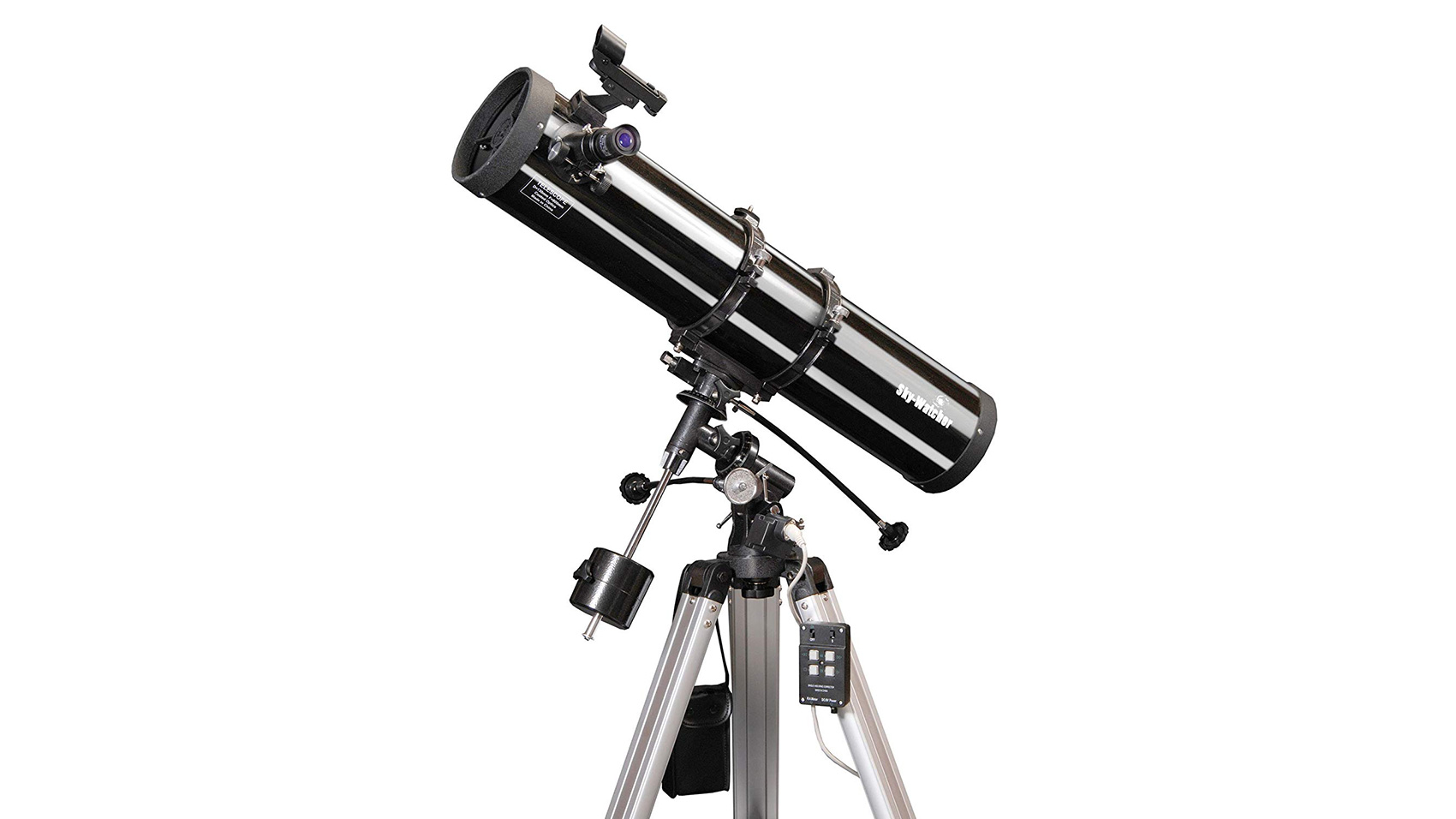
(Image credit: SkyWatcher)
1. SkyWatcher Explorer 130M
A mid-range motorised option suitable for users of all levels
Specifications
Design: Reflector
Aperture: 5"/130mm
Focal length: 35.4"/900mm
Mount: Equatorial
Level: Intermediate
Reasons to buy
+Fairly priced +Well-built +Suitable for a range of abilities +Multi-speed handset included
Reasons to avoid
-Batteries required to run the motor -Some aspects of the build are plastic-y -More demanding users will want to look elsewhere
Our pick for the best telescope overall is the SkyWatcher Explorer 130M Motorised Newtonian Reflector Telescope. It claims to be a perfect option for all levels of stargazers, whether you interest is in examining our closest planet(s) or shooting for the stars. This aluminium-constructed option's core specification comprises a 900mm focal length and an f/6.92 aperture.
Affording a relatively speedy set up, it also comes with a large accessory tray, a fully adjustable aluminium tripod and, as the picture indicates, a multi speed handset. The latter is for controlling the 360° slow motion tracking gears, while its maker claims the flexibility of this telescope's dual metal setting circles allows for the tracking of planets in the night sky by their RA (Right Ascension) and DEC (declination) coordinates. This gives their location in relation to fixed stars, while a separate latitude adjustment aids polar alignment. A well-made and sturdy option for beginners and up, this one should whet your appetite for further investigation of the Moon – and beyond!
Not sold? Check out some more mid-range all-rounders in our Celestron Inspire 100AZ refractor vs Meade Polaris 114mm reflector telescope face-off.

(Image credit: Celestron)
2. Celestron 22203 AstroFi 130 Wireless
The best premium telescope, packed with the latest tech
Specifications
Design: Newtonian Reflector
Aperture: 5"/130mm
Focal length: 25.5"/650mm
Mount: Alt-Azimuth
Level: Beginner
Reasons to buy
+Wi-Fi enabled +Crammed with the latest tech +Available app +Comes with accessory tray and eyepieces
Reasons to avoid
-Scope can't be removed from tripod -On-board Wi-Fi can be unreliable -Some plastic-y elements to the build
Bringing star gazing bang up-to-date is the Celestron 22203 AstroFi 130 Wireless Reflecting Telescope. This sturdy telescope with integrated Wi-Fi that works in conjunction with a free Celestron SkyPortal app for both iOS and Android devices – although there are some reports that the on-board Wi-Fi can be unreliable.
Aiming to provide clear views of the Moon and the planets beyond, it features a large 130mm lens and promises a wide field of view. Additionally, it helpfully comes supplied with an accessory tray for stashing your biscuits in, and more importantly two 1.25-inch eyepieces. Slightly annoyingly, this telescope cannot be removed from tripod, should you want to use it as a desktop device.
A rubber-lined area is designed to hold miscellaneous accessories including your smartphone or small tablet, presumably having first downloaded the app, which replaces the need for a remote control handset, thus streamlining the whole operation. The user holds their smart device up to the night sky and, upon locating an object they want to view, it's simply a case of tapping the screen, whereby the telescope automatically zeroes in on the object and the screen displays information about it. You can even generate a 'sky tour' of the best celestial objects to view, based on time and location. Clever stuff.
Not quite right for you? Check out our Orion SkyView Pro 8 GoTo vs Celestron Nexstar 8SE showdown for two more top-end options.
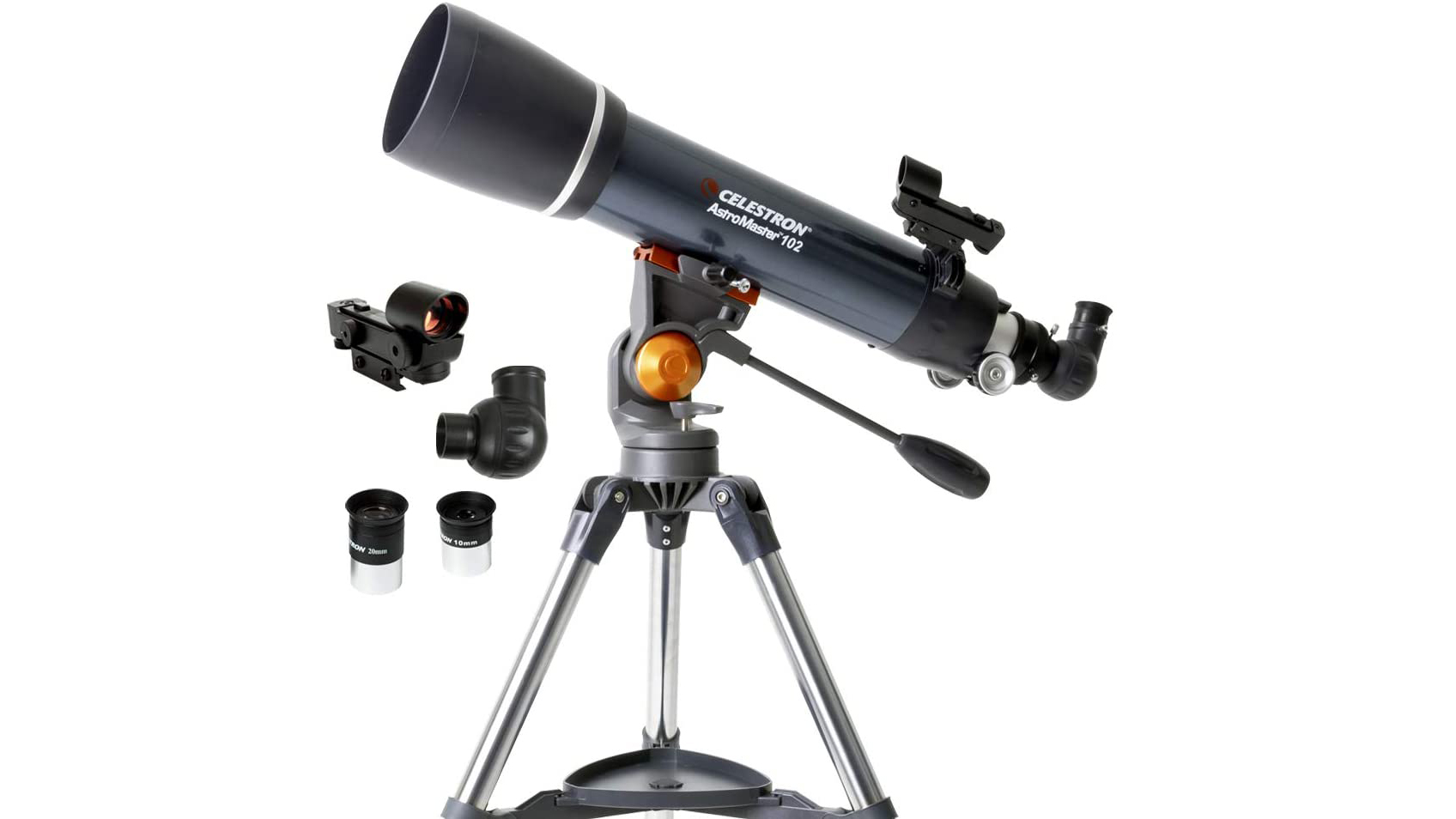
(Image credit: Celestron)
The best budget priced telescope for beginners
Specifications
Design: Refractor
Aperture: 4-inch
Focal length: 660mm
Mount: Altazimuth
Level: Beginner
Reasons to buy
+Suitable for terrestrial as well as astrological viewing +Large 102mm objective lens and generous 660mm focal length +Tripod, software and manual included
Reasons to avoid
-Heavy at 6.4kg
The Celestron AstroMaster 102AZ is an affordably priced yet fully featured refractor scope that would be perfect for budding astrologers. The massive 102mm objective lens is paired with a generous 660mm maximum focal length to deliver the kind of reach that will enable us to seek out Saturn's rings and Jupiter's moons. The altazimuth mount and pan handle setup makes it easy to locate and track objects in the night sky, but this scope is also set up for terrestrial viewing, if you like.
The bundle includes a steel tripod, accessory tray and manual, alongside 10mm and 20mm eyepieces, a red dot finder scope and Starry Night astronomy software, making for a sound starter package. It's also pretty simple to set up from scratch without the need for tools, bar a Philips screwdriver. On the downside, this AstroMaster is a bit of a beast, weighing in at 6.4kg and sporting a large footprint that means you'll need to have a bit of space at your disposal. Head to our Celestron AstroMaster 102AZ review for more info.
Not right for you? We compare two alternative beginners' telescopes in our Celestron 21039 PowerSeeker 50AZ vs National Geographic Refractor 60/700 AZ showdown.

(Image credit: Celestron)
4. Celestron Nexstar 8SE
The best hi-tech telescope
Specifications
Design: Schmidt-Cassegrain
Aperture: 8"/203mm
Focal length: 80"/2,032mm
Mount: Alt-Azimuth
Level: Advanced
Reasons to buy
+On-board computer does the hard work for you +Portable in comparison to others
Reasons to avoid
-Expensive for a hobbyist -Heavy going for beginners -Bulky -Included software is somewhat dated
Celestron is one of the best telescope brands out there, creating a huge range of devices aimed at all levels – that's why many of the telescopes on this list are from Celestron. The NexStar 8SE is one of Celestron's high-end computerised devices, which means it does the hard work for you and can automatically find more than 40,000 celestial objects with the touch of a few buttons.
It has a large 8-inch aperture and good light-gathering ability, which means you're guaranteed to get a clear view of many deep space objects with this advanced telescope. Of course there are much cheaper options available, which can give you a similar view, as well as smaller 6-inch and 4-inch models of this same telescope with a smaller price tag to match. However, this model ticks all of the boxes if you're looking for a telescope that helps you easily study the bits of the cosmos you're most interested. Amazon is currently selling the NexStar 8SE with a bundle of other fantastic stargazing additions, including an eyepiece and filter kit with 14 accessories and a phone scope adapter. The latter enables you to easily take photos of the objects you spot in space.
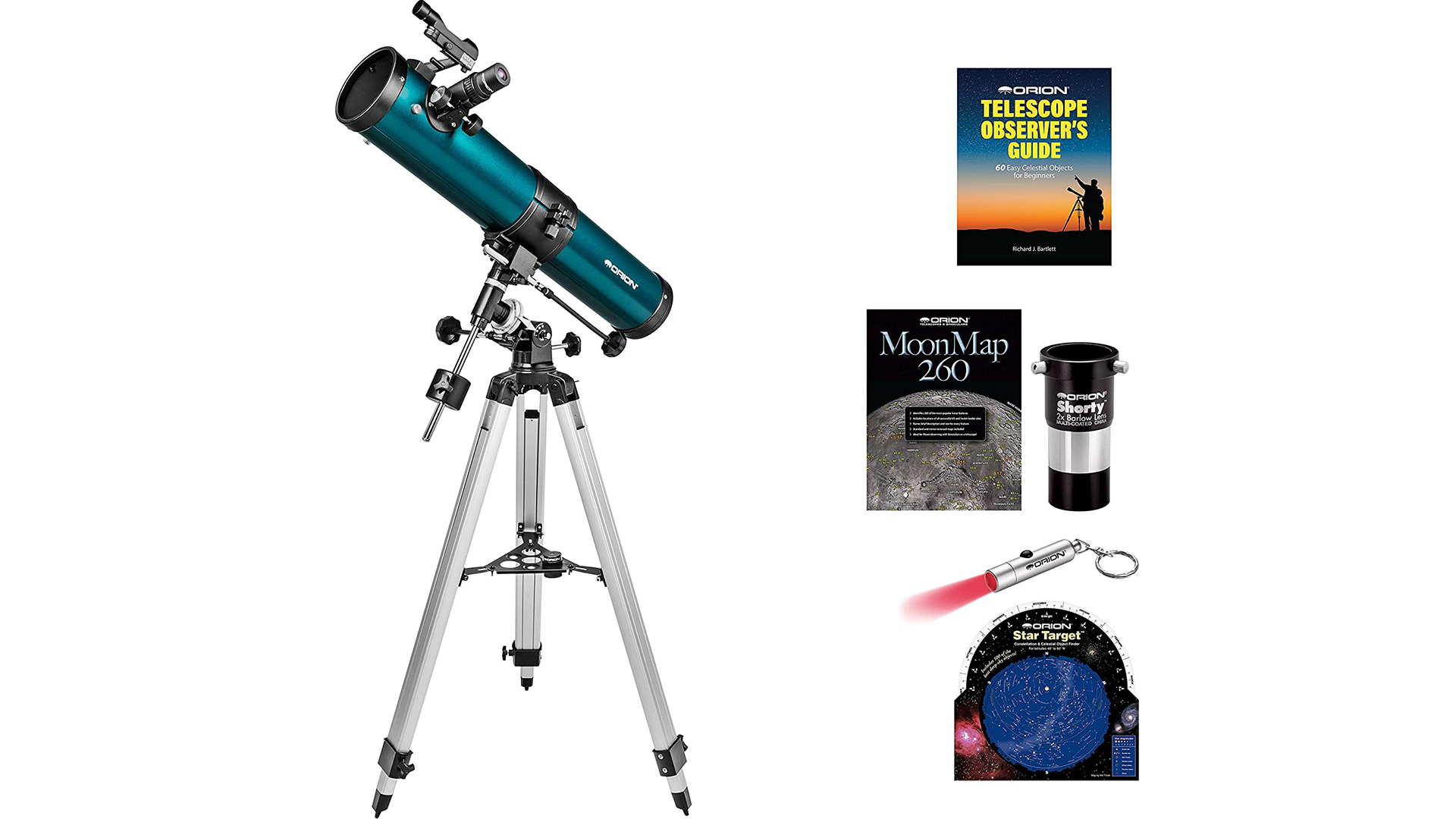
(Image credit: Orion)
5. Orion SpaceProbe II
Another excellent telescope for fledgling stargazers
Specifications
Design: Reflector
Aperture: 3"
Focal length: 700mm
Mount: Equatorial
Level: Beginner
Reasons to buy
+Beginner friendly +Affordable
Reasons to avoid
-More eyepieces would be useful -Red dot sight for aiming requires batteries
Featuring a large-ish 76mm objective lens to deliver detail in the dark, the Orion SpaceProbe II is an excellent telescope for those new to stargazing. It comes with a 2x Barlow lens that doubles the magnification of both the included eyepieces – for example bestowing 56x magnification on the standard 25mm eyepiece rather than 28x, and a whopping 140x on the 10x eyepiece rather than 70x. In an ideal world, we'd like a greater number of eyepieces to provide even greater opportunities for amateur stargazing, but what's included here is plenty to get going with.
While most starter scopes are suitable for viewing the Moon and not a great deal more, when the eyepieces are combined with the SpaceProbe II's core 700mm focal length, users say they've been able to explore further planets, bright nebulas and star clusters. The scope also comes with both a Star Target 'planisphere', Moon Map and beginners' guide book to direct our gaze heavenwards.
To save us fumbling around in the dark, a mini flashlight is further included in the kit, while the provided tripod allows for slow and steady tracking of objects of interest. In short there's enough here to quickly get amateur stargazers conducting their own deep space 'probes' straight out of the box. Look out for the version that provides an upgraded Equatorial or 'EQ' mount rather than the Altazimuth mount of earlier versions.

(Image credit: Unistellar)
See deep-sky objects in stunning detail with this super-smart telescope
Specifications
Design: Reflector
Aperture: 4.5"/114mm
Focal length: 17.7"/450mm
Mount: Motorised Alt-Azimuth
Level: Beginner
Reasons to buy
+Easy to set up +Incredible views
Reasons to avoid
-Slow to focus -FOV too small for the Moon -Lack of conventional eyepiece will put some off -High end price for this high tech device
Everyone knows that telescopes are for looking through. Except for this one. Unistellar's eVscope eQuinox is a definite oddity because it doesn't have an eyepiece; instead it connects to your smartphone or tablet via an app so you can see the stars on your screen. This may seem as if it takes half the fun out of stargazing, but there's one big advantage to this approach: thanks to the eVscope eQuinox's built-in image processing, you'll be able to see the skies much more clearly than you would simply peering through an eyepiece.
It uses live light accumulation to fix on a tiny point in space and build up images of deep sky objects in impressive detail, albeit eventually. It can take a good few minutes for 'live' image to feed through to your device, but once it does you'll find it's been well worth the wait. And as an added bonus, the Unistellar app has a built-in catalogue of 5,400 objects, making it easy for absolute beginners to quickly find obscure ring nebulae and spiral galaxies to look at.
Currently available to pre-order at the frankly heart-stopping price of $2,999/£2,599/€2,799 (shipping not included) it's not for everyone, especially when you bear in mind that its field of view is so narrow that it can't take in the whole Moon in one go. But if you want to see into the depths of space, even from a light-polluted back garden, this oddball telescope's well worth the investment; find out more in our Unistellar eVscope eQuinox smart telescope review.
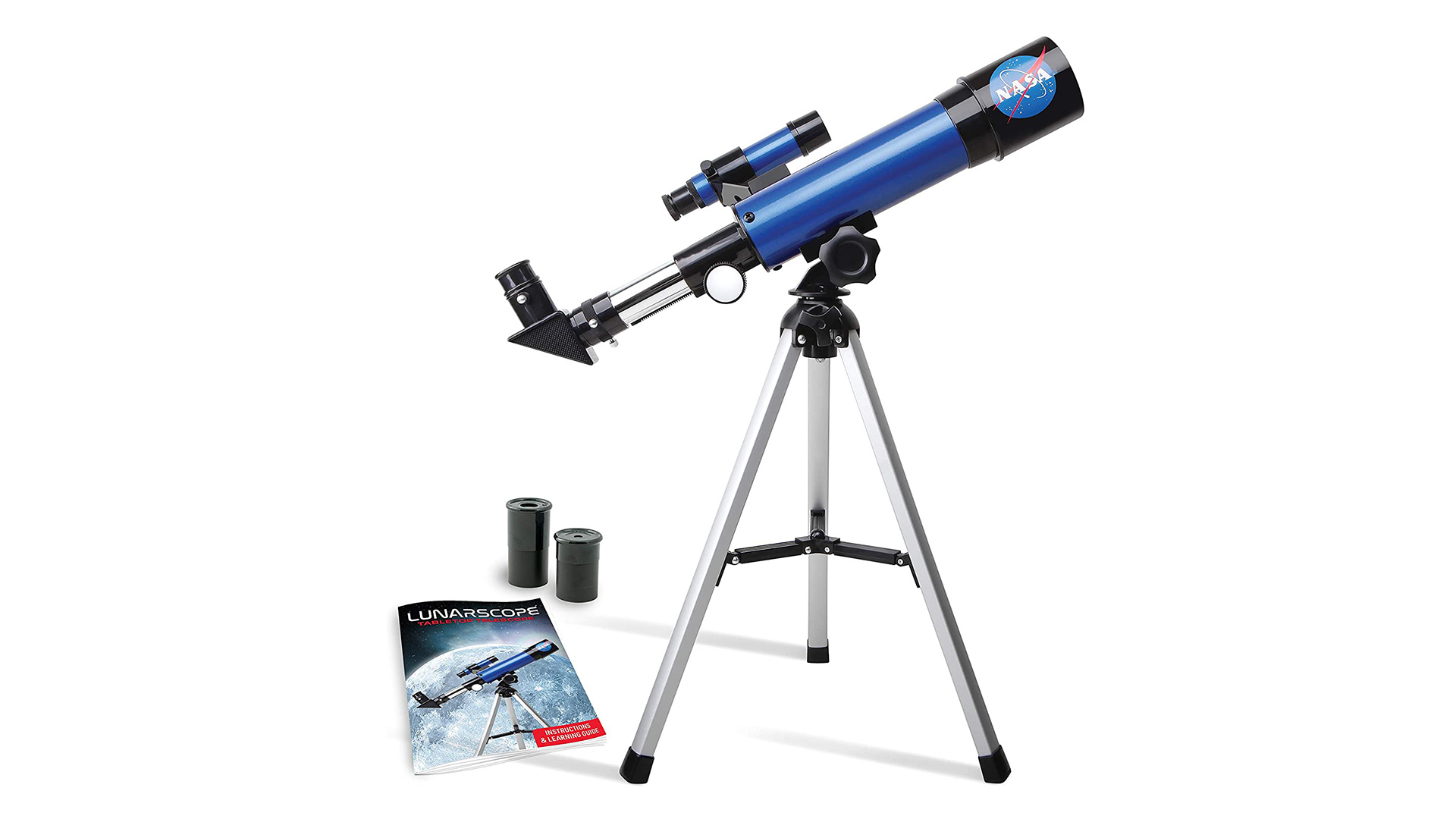
(Image credit: Nasa)
7. Nasa Lunar telescope for kids
The best budget telescope for kids
Specifications
Design: Refractor
Aperture: 2"/50mm
Focal length: 14.1"/360mm
Mount: Equatorial
Level: Beginner
Reasons to buy
+User-friendly starter kit +Inexpensive, so won't matter if the kids lose interest +Hey, it's got a cool NASA sticker on it
Reasons to avoid
-No separate/optional high powered eyepieces available for this model -Scope and tripod both on the small side -For the under 10s only
Which telescope is the best match for small fingers and curious minds? The aptly named Nasa Lunar telescope (hey, before you can shoot for the stars, best you first aim for the moon) even comes with a NASA sticker to excite the imagination of future astronauts, with the claim that it's been designed to engender a love of scientific pursuits.
Promising easy assembly, one of the best things is that this doesn't outwardly resemble a cheap toy, yet is still child's play to use, with a tabletop tripod and instructional guide book included to get fledgling voyages to the stars underway. A finder scope along with both low and high power eyepieces are included; a combination that lets children first pinpoint the moon before then zooming in for a close up view. Up to 90x magnification is provided here, enabling the little ones to surely determine the answer to the age-old question: is our nearest neighbour really made of cheese?

8. Celestron Travelscope 70 Portable
A rugged telescope that's built for adventures
Specifications
Design: Refractor
Aperture: 2.7"/70mm
Focal length: 15.7"/400mm
Mount: Alt-Azimuth
Level: Beginner
Reasons to buy
+Ideal for those who want to stargaze on-the-move +Great value for money
Reasons to avoid
-Quality and experience is far from premium -Tripod legs too short to use whilst standing -Best for surveying the Moon, anything further is a stretch
Plenty of people want an old-school-style telescope that'll look nice in their bedroom or living room and stay put. But if you're a fan of the great outdoors, or live in a city and can't see great views because there's just too much light pollution, you're going to need a telescope that likes to travel along with you. Luckily, Celestron has a light and portable telescope called the Travelscope 70, which is lightweight, mobile and even comes with its own backpack making it perfect for travelling, hiking and any other kind of outdoorsy adventure. Of course packing optical tech into a smaller, lighter frame is going to mean a slightly less premium experience when it comes to the quality of the tripod and lenses, as well as magnification. But for the price, it's ideal for beginners, travellers and even kids who you're not sure are likely to keep their new hobby up for long.

9. Celestron AstroMaster 130EQ
A highly-capable telescope for taking on camping trips
Specifications
Design: Refractor
Aperture: 2.7"/70mm
Focal length: 15.7"/400mm
Mount: Alt-Azimuth
Level: Beginner
Reasons to buy
+Provides fantastically clear images +A no-tool set-up process
Reasons to avoid
-Stability of the mount and tripod could be better -Higher powered eyepieces would be useful
The Celestron AstroMaster 130EQ is a very capable reflector telescope that has a sturdy, fairly large build. But despite its solid design and stability, you don't need tools to set it up – and, it's easy to pack away for taking camping or to stargazing events. It has everything you need to get started: a 10mm and 20mm eyepiece, a StarPointer red dot finderscope and free astronomy software to teach you the basics. The telescope has an Equatorial Mount, which allows you to track objects smoothly as they move across the sky, providing bright, clear images of the Moon, planets, star clusters, and much, much more. On the down-side, higher powered eyepieces than the ones provided would be a distinct advantage.
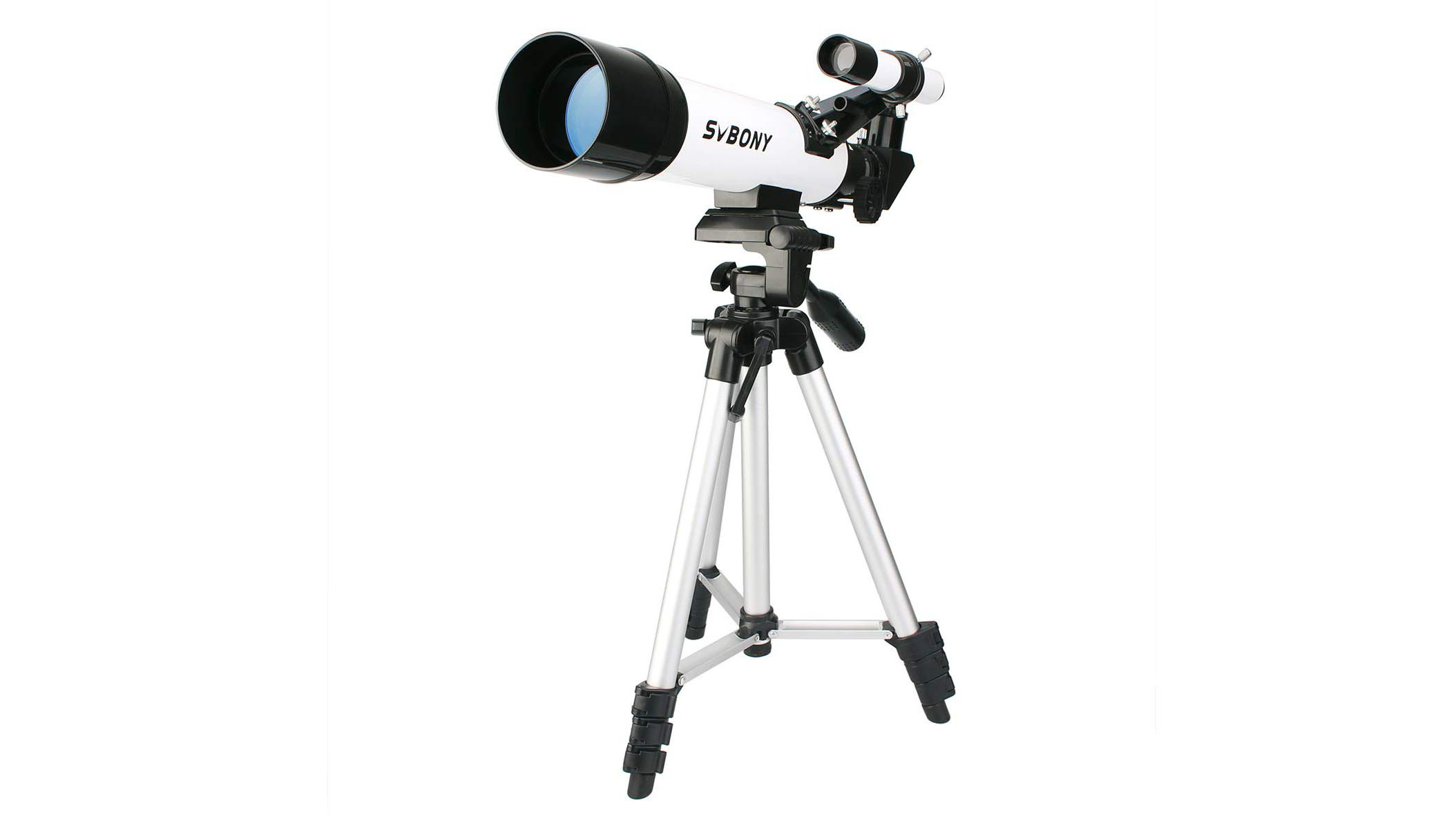
(Image credit: Svbony)
10. Svbony SV25 Refractor Telescope
A good small telescope for stargazing newbies
Specifications
Design: Refractor
Aperture: 60mm
Focal length: 420mm
Mount:
Level: beginner
Reasons to buy
+Light and portable +Super easy set-up
Reasons to avoid
-Stability of the provided tripod could be improved -Unsuitable for looking any further than the Moon
This quick to set-up, small telescope is perfect for beginners and children who want to try stargazing for the first time. The great thing about this telescope is because it's small and easy to get up-and-running, it gives those new to looking at space more confidence before they graduate to a bigger telescope – without the commitment or big price tag. This 60mm aperture refractor telescope comes with an adjustable aluminium tripod, which can keep the scope stable as you stargaze, as well as a phone mount adapter so you can easily take photos and videos of what you spot in the sky. Because it's an entry-level telescope aimed mainly at kids, it's good for looking at the Moon, closer objects and even land objects, but you'll need a more advanced scope to be able to see other objects in the night sky in more detail.
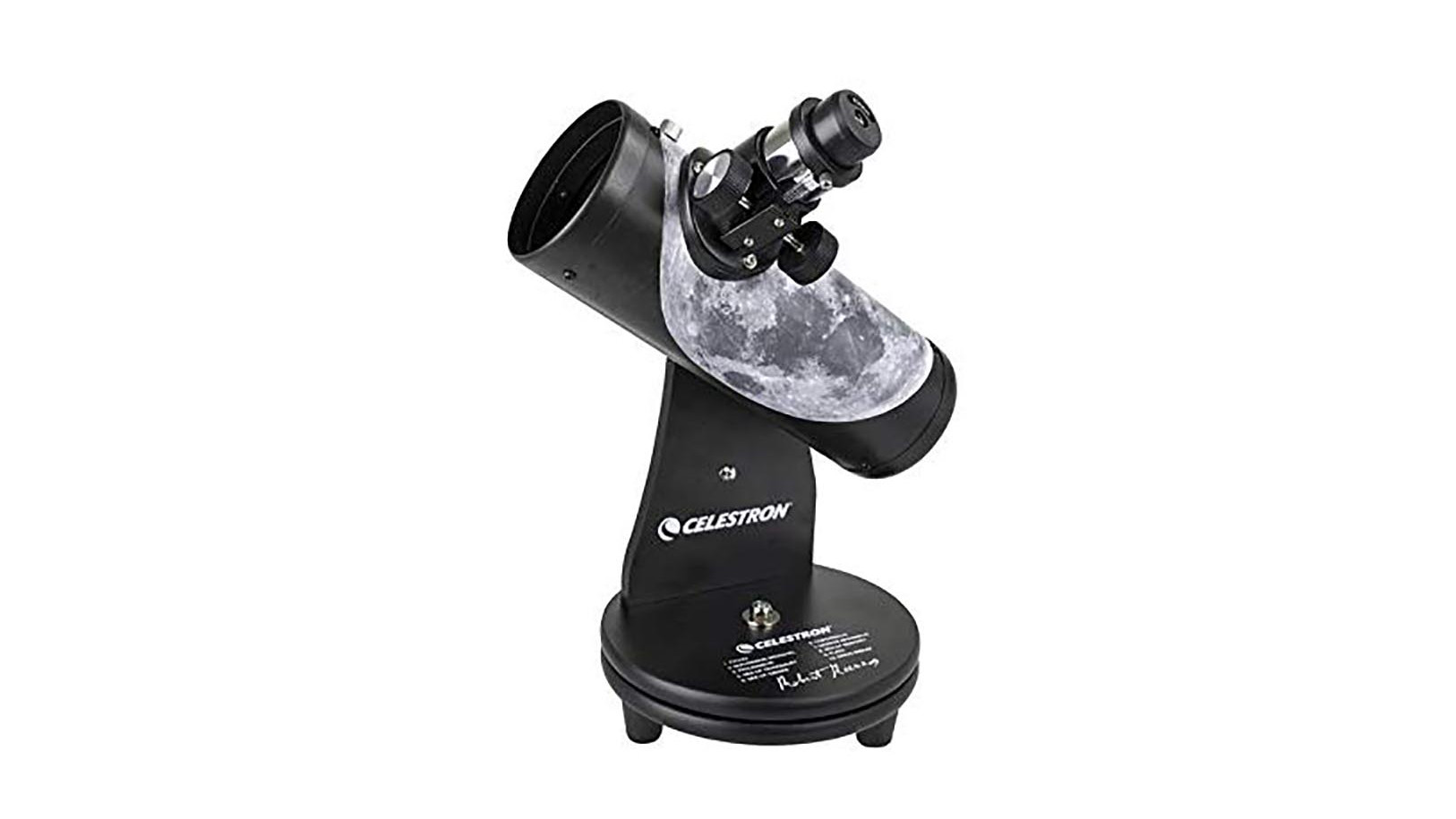
(Image credit: Celestron)
11. Celestron 76mm Firstscope Apollo 11 Edition
A tabletop telescope for lunar lovers
Specifications
Design: Reflector
Aperture: 76mm
Focal length: 300mm
Mount: Dobsonian
Level: beginner
Reasons to buy
+Tabletop design makes it easy to move and view +Amazing Apollo 11 extras
Reasons to avoid
-For beginners only -No finder scope includes
The Celestron 76mm Firstscope is another strong choice for beginners. While more experienced users will want a scope with a bit more poke, this lightweight, tabletop design is a great choice for kids or anyone else who might struggle with a larger scope on a tripod. It's a Dobsonian-style telescope with a 76mm aperture reflector optical tube attached, which makes navigating the night sky really easy, all you have to do is point the tube and take a look. Be aware you're just getting the basics here – there's no finder scope provided to aid navigation further.
Black Friday telecope deals: when's the best time to buy?
Traditionally, the Black Friday sales are a great time to pick up a quality telescope at a cut price. Sadly, the 2020 Black Friday telescope deals were woefully thin on the ground, both in the US and the UK. This isn't what we'd usually expect: demand for the best telescopes increased in the early months of the pandemic, which meant that in the US at least, many ranges sold out completely well ahead of time.
The market seems to have stabilised a bit now, so we're hoping for some better telescope deals for Black Friday 2021. The official event takes place on 26 November, with Cyber Monday following on 29 November. While the best offers are usually concentrated on those two days (the Friday in particular), in recent years we've seen deals going live early, so it's worth keeping an eye out in the preceding week or so.
The other major shopping event to take note of is Amazon Prime Day. The 2021 event took place in June, and we saw one great beginner telescope deal in the UK – the EMARTH refractor telescope dropped by 44% for Prime subscribers, taking it down to less than £60.
In 2020, the event got shifted to October on account of the pandemic, and there were some decent discounts on Celestron telescopes as well as binoculars and sporting scopes.
We'll be keeping a close eye out for any price drops that do occur, and our dedicated tool will pull in all the cheapest prices on the products in our ranking at all times, so you can be sure you're not overpaying.

(Image credit: Celestron)
The best beginners' telescope for both land and sky viewing
Specifications
Design: Refractor
Aperture: 4-inch
Focal length: 660mm
Mount: Altazimuth
Level: Beginner
Reasons to buy
+Dual purpose: as equally suited to terrestrial use as astrological observation +Large 102mm objective lens and generous 660mm focal length +Tripod, software and manual all included
Reasons to avoid
-Weighs a hefty 6.4kg
Which little kid hasn't dreamed of growing up to become an 'AstroMaster'? With this affordable refractor scope aimed at budding astrologers – that can also be used for terrestrial viewing – now we all can live that dream. Key features include a whopping 102mm objective lens and generous 660mm maximum focal length; the kind of reach that will enable us to seek out Saturn's rings and Jupiter's moons.
Beginner friendly features include the fact that it can be set up from scratch without the need for tools of any kind, and, like most in its price bracket, usefully includes a steel tripod, accessory tray and manual. Allowing for impromptu observations from the back garden as well as the back window, it's deemed portable enough to be picked up and transported in a jiffy. That said, at 6.4kg in weight the AstroMaster not the most lightweight option out there. Nevertheless its altazimuth mount and pan handle set up allows objects in the night sky to be quickly located and tracked. Also included are 10mm and 20mm eyepieces, a red dot finder scope and Starry Night astronomy software, making for a sound starter package. Head to our Celestron AstroMaster 102AZ review for more info.
What's a Good Telescope for Looking at Planets
Source: https://www.t3.com/features/best-telescope
0 Response to "What's a Good Telescope for Looking at Planets"
Post a Comment